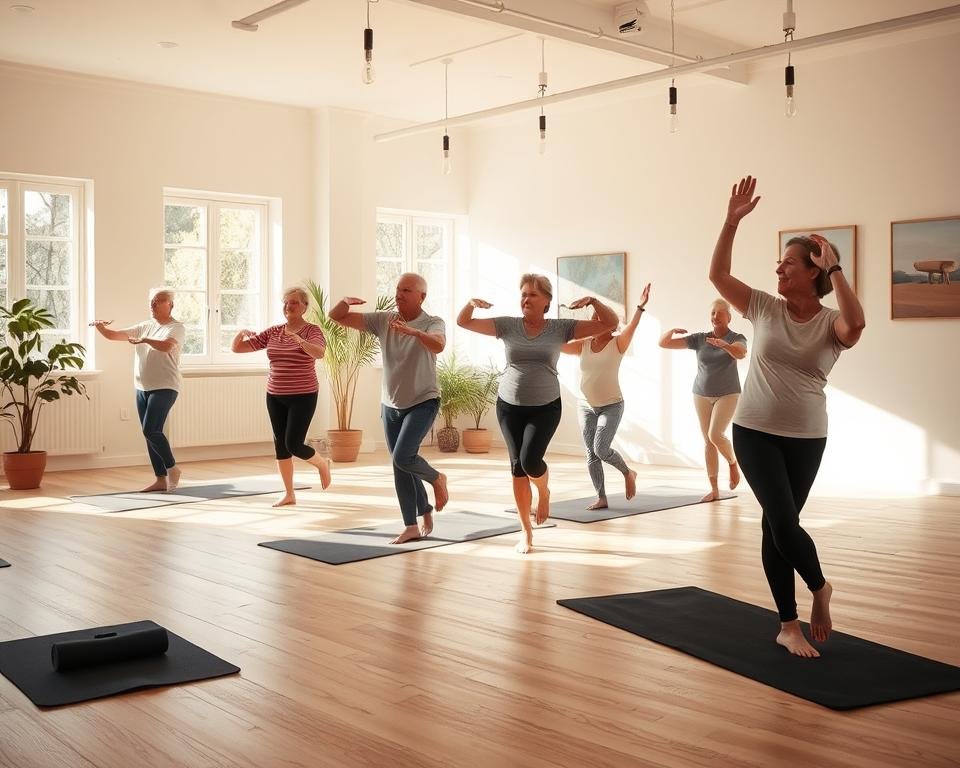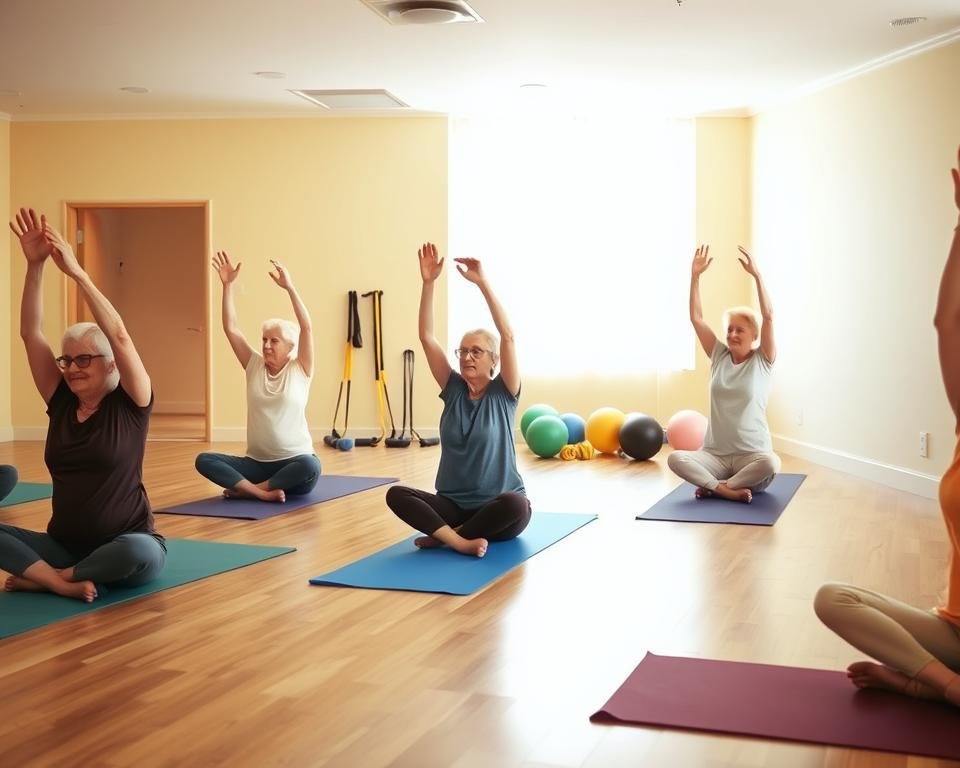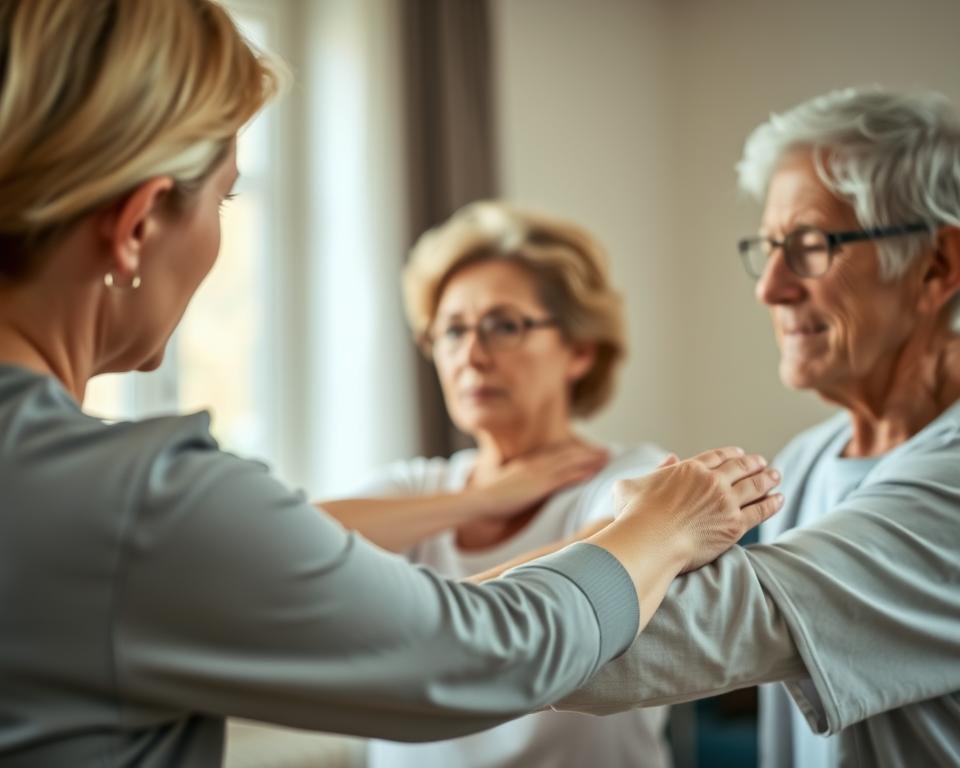“An ounce of prevention is worth a pound of cure.” – Benjamin Franklin’s timeless wisdom rings especially true when it comes to staying safe as we age. For older adults, maintaining independence often starts with creating a secure environment that minimizes the chance of accidents.
Did you know 1 in 4 Americans aged 65+ experiences a fall each year? These incidents account for over 36,000 annual deaths and $50 billion in medical costs, according to CDC data. While aging brings natural changes to your body’s strength and coordination, many risks can be managed through smart planning.
Common hazards like loose rugs or poor lighting often mix with health factors like medication side effects or reduced mobility. The good news? Simple adjustments – from home modifications to balance strength exercises – can dramatically lower your risk while keeping you active.
This guide will walk you through practical steps to protect your well-being. We’ll explore how to assess your home’s safety, work with your doctor to review medications, and build physical resilience through targeted movements. Let’s create a personalized plan so you can thrive confidently in your daily life.
Key Takeaways
- 1 in 4 adults over 65 falls annually, often leading to serious injuries
- Combining home safety checks with health management reduces risks
- Regular exercise improves stability and lowers accident likelihood
- Consulting your doctor about medications prevents dizziness hazards
- Small daily adjustments help maintain long-term independence
Understanding Your Fall Risk
Staying safe starts with knowing what could trip you up—literally and figuratively. Your body and surroundings work together in ways that might surprise you. Let’s break down the two main categories of risks so you can spot them early.
What’s Happening Inside Your Body
Age-related changes often sneak up quietly. Maybe you’ve noticed it’s harder to get up from chairs, or your depth perception isn’t what it used to be. Nearly 30% of seniors report balance issues that make daily movements trickier. Medications for blood pressure or sleep can add to these challenges by causing dizziness.
Vision changes matter more than you might think. Diminished eyesight makes judging distances harder, especially in low light. Regular checkups with your eye doctor help catch these shifts early.
Spotting Trouble Around Your Home
Your living space should be your safest zone, but common items can become hazards. That throw rug by the couch? It’s a top culprit for slips. Nighttime bathroom trips become risky when you’re navigating dark hallways.
Look for these trouble spots:
- Cluttered walkways or loose electrical cords
- Furniture that wobbles when leaned on
- Stairs without sturdy handrails
Combining body awareness with home safety checks gives you real power. If bending becomes difficult, ask a family member or physical therapist for help rearranging high-use areas. Remember—most risks can be managed once you know where to look.
Effective Fall Prevention Strategies
Your daily movements hold surprising power to keep you steady. Simple activities like standing up from a chair or walking across a room become opportunities to build resilience. Studies show regular physical activity can slash accident likelihood by up to 23%—and it’s never too late to start.

Move Smart, Stay Steady
Targeted movements train your muscles and nerves to work together smoothly. Try the sit-to-stand exercise: rise from a sturdy chair using your legs, not armrests. Hold for three seconds, then lower slowly. Repeat five times daily to build lower-body power.
Balance drills like standing on one foot while holding a countertop sharpen stability. Start with 10-second holds, gradually increasing as you gain confidence. Physical therapists often recommend these techniques because they mimic real-life challenges.
Partner With Your Healthcare Team
Your medications might need a tune-up. Blood pressure pills, sleep aids, and some pain relievers can cause unsteadiness. Schedule time to talk doctor about adjusting doses or switching formulas if needed.
Remember:
- Review prescriptions annually or after health changes
- Ask about vitamin D supplements—they support muscle function
- Report any dizziness immediately
Start new routines slowly, and always check with your care provider first. Small efforts today create lasting protection, letting you enjoy favorite activities with greater confidence.
How to Create a Fall-Proof Home Environment
Your living space can become your safest ally with thoughtful adjustments. Start by tackling areas where slips and stumbles commonly occur—often in plain sight.
Eliminating Clutter and Trip Hazards
Walk through each room like a detective. Tape down loose carpets with double-sided adhesive or remove them entirely. Secure electrical cords along baseboards using cable clips—no more toe-catching wires!
High-traffic zones need special attention:
- Keep staircases free of shoes or packages
- Store frequently used items at waist level
- Use non-slip mats under area rugs
Check these areas weekly. If bending challenges you, ask a family member to help rearrange low shelves or floor-level storage.
Enhancing Lighting and Installing Grab Bars
Dark hallways become danger zones after sunset. Plug in nightlights along pathways to bathrooms and kitchens. Swap dim bulbs with daylight-spectrum LEDs—they brighten spaces without glare.
Bathrooms benefit most from added support:
- Install grab bars near toilets and showers
- Use a shower chair with rubber-tipped legs
- Keep towels within arm’s reach
Consider a room-by-room safety audit to spot hidden risks. Proper footwear matters too—choose shoes with textured soles even indoors.
Balance and Strength Exercises for Stability
Building physical resilience starts with simple, purposeful movements. Regular practice strengthens muscles and sharpens coordination, helping you stay steady during daily activities. Let’s explore two foundational routines that adapt to your current fitness level.

Mastering the Sit-to-Stand Technique
Start by sitting in a sturdy chair with feet flat. Lean slightly forward, shifting your body weight over your thighs. Push through your heels to rise slowly, keeping knees aligned. Hold for 3 seconds, then lower with control. Aim for 8-10 repetitions daily.
Beginners can use armrests for support. Advanced users might try crossing arms or adding light weights. This exercise targets quadriceps and core muscles—key players in maintaining stability.
Developing a Progressive Balance Exercise Routine
Begin by holding a countertop while standing on one foot. Lift your right leg slightly, focusing on a fixed point ahead. Start with 10-second holds per side, working up to 30 seconds. As confidence grows, practice without hand support.
For variety:
- Walk heel-to-toe along a straight line
- Shift weight side-to-side during TV commercials
- Stand on foam pads to challenge stability
Consistency matters most. Pair these exercises with morning coffee or evening news time. Strength gains compound over weeks—research shows just 15 minutes daily reduces risk by 40% in 3 months.
Always keep your chair nearby for safety. Celebrate small victories, like holding a pose 2 seconds longer. Your body’s ability to adapt will surprise you!
Addressing Medical and Medication-Related Risks
Your health team plays a bigger role in staying upright than you might realize. Many older adults discover that subtle changes in prescriptions or untreated health factors quietly increase their risk of losing balance. Proactive care helps you stay ahead of these hidden challenges.
Regular Health and Vision Check-Ups
Clear eyesight does more than help you read labels—it’s essential for judging distances and spotting obstacles. Schedule annual vision exams to catch cataracts or glaucoma early. Ask your doctor about depth perception tests during routine visits.
Don’t overlook these key screenings:
- Blood pressure checks during morning and afternoon
- Vitamin D levels affecting muscle strength
- Foot exams to detect numbness or circulation issues
Managing Side Effects and Dosage With Your Doctor
Four out of five seniors take medications that could cause dizziness. Always bring your pill bottles to appointments—this helps your doctor spot interactions. “Many patients don’t realize sleep aids or pain relievers affect balance,” explains geriatric nurse Linda Carter.
Take charge of your prescriptions:
- Discuss lower doses if you feel unsteady after taking pills
- Ask about alternatives to drugs causing brain fog
- Use pill organizers with support from family members
If back pain or arthritis makes movement harder, a physical therapist can suggest safer ways to bend or reach. Remember—small medication tweaks today can prevent falls tomorrow while keeping you independent.
Securing Support and Professional Guidance
Staying steady isn’t a solo mission—it’s teamwork at its best. Whether you’re recovering from a recent stumble or building long-term stability, combining expert advice with loved ones’ help creates layers of protection.

When to Consult a Physical Therapist
Notice persistent unsteadiness when turning or reaching? A physical therapist can design movements tailored to your needs. They’ll assess your body mechanics and create routines that improve strength where you need it most—like ankles or hips.
Consider scheduling an evaluation if you:
- Feel dizzy after standing up quickly
- Struggle with stairs despite regular exercise
- Need modifications for existing health conditions
“Keep in mind, it’s always best to have company at home while exercising,” advises mobility expert Dr. Ellen Torres. Pairing professional guidance with a buddy system keeps you accountable and safe.
Involving Family and Friends for Safety
Your inner circle offers more than companionship—they’re extra eyes for spotting risks. Ask them to join your home safety walkthroughs or practice balance drills together. Simple actions make a big difference:
- Schedule weekly walks to maintain foot strength
- Rearrange kitchen items as a team to avoid risky reaches
- Share medication lists for cross-checking side effects
Regular check-ins with your doctor and loved ones build confidence. Remember, seeking support isn’t about losing independence—it’s about safeguarding your ability to enjoy life fully.
Practical Daily Tips for Fall Prevention
Your morning routine holds hidden opportunities to build safety. From the moment you step out of bed to evening relaxation, small choices create layers of protection against stumbles.
Smart Shoe Choices and Posture Tweaks
Swap slippers with smooth soles for shoes featuring textured rubber bottoms. Look for wide toe boxes and firm heel support—these features help your feet grip surfaces better. When sitting, practice rolling your shoulders back every hour to maintain proper body position.
Try these quick adjustments:
- Place frequently used kitchen items at waist level
- Do calf raises while brushing teeth
- Use a nightlight with motion sensors in hallways
Keep pathways clear by immediately returning items to their spots. A 2-minute evening sweep of living areas reduces morning risk. Pair this habit with seated leg lifts during phone calls to blend exercise into your day.
Reassess your space monthly—new hazards can appear quietly. That stack of books by the stairs? Relocate it today. Remember, consistency with these steps helps your body and home work together seamlessly for lasting confidence.
Conclusion
Your journey to staying steady combines smart habits with simple home tweaks. You’ve learned how targeted exercises improve balance while securing your space reduces hidden hazards. Remember—regular movement strengthens knees and core muscles, making daily tasks safer.
Check your home weekly for loose rugs or dim lighting. Use a sturdy chair for seated exercises, keeping feet flat on the ground. Adults who pair these steps with annual vision exams and blood pressure checks see the best results.
Make these changes stick:
- Practice standing from a starting position slowly
- Ask family to help rearrange high shelves
- Review medications with your doctor each season
Research shows consistent effort can reduce risk falling by over 30%. Small changes add up—like using nightlights or wearing grippy shoes. You’ve got this! Start today—your independence is worth every effort.
